Table of Contents
In this tutorial you will learn how to create a structured body-fitted grids for the simple geometry of the flat plate, which are provided to the MAIA solver in the next tutorials of this series. For that purpose, you will create two grids, i.e., a two-dimensional grid for a Reynolds-Averaged-Navier-Stokes simulation (2D RANS) and a three-dimensional grid for a Large Eddy Simulation (LES) to approximately solve the Navier-Stokes equations with a structured finite volume solver. For more details about the numerical methods, please refer to the following sections on the structured grid and the structured finite volume solver.
- Todo:
- More information about the tutorial folder structure, if we agreed on one (structure and location where to download from).
Theory
In the following tutorials, the zero-pressure gradient (ZPG) turbulent boundary layer flow over a wall actuated by a sinusoidal wave motion is analyzed in a Cartesian domain with the x-axis in the main flow direction, the y-axis in the wall-normal direction, and the z-axis in the spanwise direction. All lengths are non-dimensionalized by the momentum thickness of the boundary layer at \( x_0 = 0 \) such that \( \theta (x_0 = 0) = 1 \). The momentum thickness based Reynolds number is \( \mathrm{Re}_{\theta} = u_{\infty} \theta / \nu = 1,000 \) at \( x_0 \). The Mach number is \( \mathrm{M} = u_{\infty} / a_{\infty} = 0.1 \), i.e., the flow is nearly incompressible. Starting with the reference resp. unactuated case, the setup is sketched as follows, where BC stands for boundary condition:
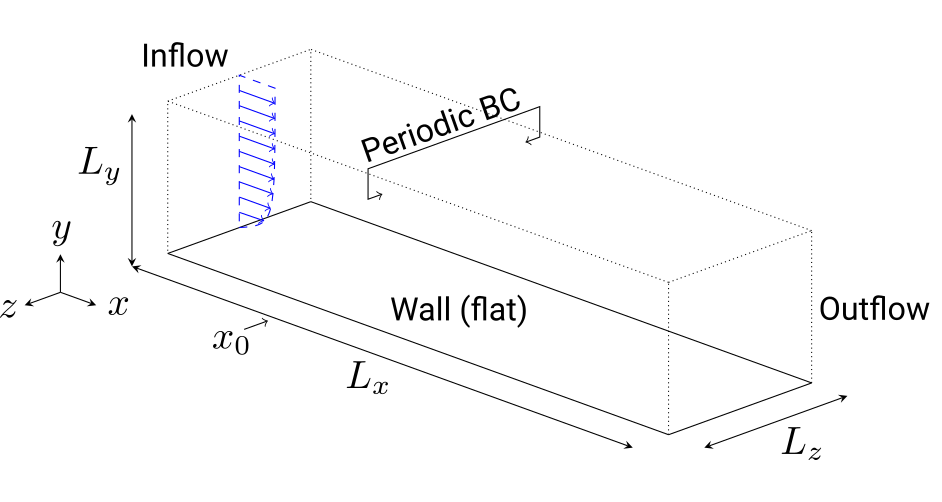
At the end of this series of tutorials the wall is actuated by spanwise traveling transversal surface waves to reduce the friction drag. Note that unlike standard ZPG turbulent boundary layer flow, the actuated flow is statistically three-dimensional due to the wave propagating in the \( z \)-direction. More information about the numerical setup and methods can be found in this paper [Albers2020].
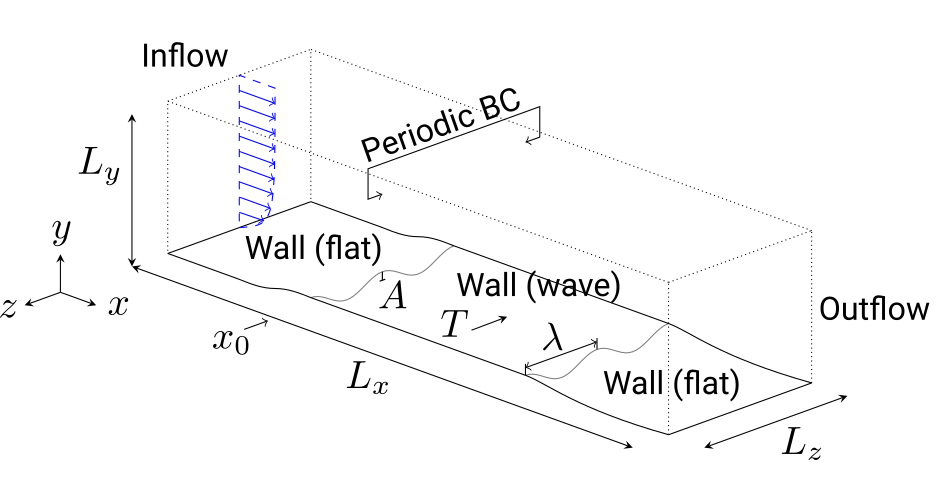
- Note
- To reduce computational costs, the grid resolution is decreased in comparison to the real-world simulations, rendering the results less physically plausible.
Tutorial
Download and unzip this tutorial here and change the directory to the grid generation folder
1_grid.cd 1_grid
Create symbolic links to the compiled MAIA executable (if not already, please refer to the setup tutorial) and to the Python files which are needed to create/make, visualize the grid and to reset/clear the tutorial for the next test run. The last mentioned files are located one level up in the
toolsfolder.
ln -s maiaDirectory/Solver/src/maia maialn -s ../tools/grid/make_grid.py make_grid.pyln -s ../tools/grid/post_grid.py post_grid.pyln -s ../tools/grid/clear_grid.py clear_grid.pyTest if MAIA is correctly linked by opening MAIA's help:
maia -h
Open and have a look at the
properties_grid.tomlfile, which contains the settings used for creating the structured grid.
Porperty Explanation ma Mach number \( \mathrm{M} = u_{\infty} / a_{\infty} \) with the free stream velocity \( u_{\infty} \) and the speed of sound of the free stream \( a_{\infty} \) re_theta momentum thickness based Reynolds number \( \mathrm{Re}_{\theta} = u_{\infty} \theta / \nu \) at \( x_0 \) les_grid_name Name for the 3D LES grid to be generated and saved rans_grid_name Name for the 2D RANS grid to be generated and saved les Boolean if to create a grid for LES rans Boolean if to create a grid for RANS les_inflow_bc LES inflow boundary condition, 7909for the synthetic turbulence generation (STG) method. At the initial startup a restart file with a RANS velocity profile and \nu_t profile needs to be provided. The methods computes a given number of synthetic eddies and induces their fluctuations to the mean flow, thus creating turbulent boundary layer flow. Not necessarily needed formake_grid.py.les_wall_bc LES wall boundary condition, 1000for no-slip wallrans_wall_bc RANS wall boundary condition, 1000for no-slip wallles_outflow_bc LES outlfow boundary condition, 2004for subsonic outflowrans_outflow_bc RANS outlfow boundary condition, 2004for subsonic outflowx_start_rans Streamwise starting point of the domain of the RANS x_start Streamwise starting point of the domain of the LES, i.e., \( x_0 = 0 \) y_wall Wall location, i.e., \( y = 0 \) lx_rans Streamwise domain size of the RANS lx Streamwise domain size of the LES lx_fringe_start Streamwise starting point of the region in which the streamwise grid resolution is coarsened towards the outlfow lx_fringe_growth Growth factor, like 1.05for \( 5 \% \), of the region in which the streamwise grid resolution is coarsened towards the outlfowly Wall-normal domain size lz_plus Spanwise domain size in inner units dx_plus Streamwise grid resolution in inner units dy_plus_wall Wall-normal grid resolution at the wall in inner units dy_plus_edge Wall-normal grid resolution at the edge (distant from the wall) in inner units dz_plus Spanwise grid resolution in inner units rans_stretch Stretch factor of the streamwise resolution of the RANS grid in comparison to the LES grid, i.e., dx_rans = rans_stretch * dx_lesbl_edge Number of boundary layer edge points wall_normal_method NOT USED RIGHT NOW IN THE TUTORIAL in make_grid.py: Method number of how to construct the wall normal points, i.e.,1,2,3, where3is the method described in the paper [Albers2020]- Note
- Inner units, which is a non-dimensionalization using the friction velocity \( u_{\tau} = \sqrt{ \frac{ \tau_{\mathrm{wall}} }{ \rho } } \), i.e., \( y^+ = \frac{ y u_{\tau} }{ \nu } \) and \( u^+ = \frac{ u }{ u_{\tau} } \) and \( t^+ = \frac{ t u^2_{\tau} }{ \nu } \), are indicated by a \(+\)-superscript resp. by
_plusin the code. For more information, please refer to the "law of the wall".
Create the grids used for the next tutorials by running the
make_grid.pyfile and using the settings defined in theproperties_grid.tomlfile.python3 make_grid.py -p properties_grid.tomlWhen running
make_grid.pywithproperties_grid.tomlthe following is printed to the console:properties_grid.toml40.0dy_edge target: 1.052605Iteration: 0 Delta at BL-edge: 0.201661 Growth: 1.010808 Inc: 0.808418 Number of points: 137Iteration: 1 Delta at BL-edge: 0.212905 Growth: 1.011671 Inc: 0.797735 Number of points: 132Iteration: 2 Delta at BL-edge: 0.227074 Growth: 1.012586 Inc: 0.784274 Number of points: 128...Iteration: 97 Delta at BL-edge: 1.052605 Growth: 1.067292 Inc: 0.000000 Number of points: 48Iteration: 98 Delta at BL-edge: 1.052605 Growth: 1.067292 Inc: 0.000000 Number of points: 48Iteration: 99 Delta at BL-edge: 1.052605 Growth: 1.067292 Inc: 0.000000 Number of points: 48######################################Re_theta: 800.000000 c_f: 0.004513 tau_w: 0.000022 u_tau: 0.004745dx: 1.052605 dy_wall: 0.052630 dz: 0.263151y: 0.0 dy: 0.05263027436427487 dy_plus: 2.000000 j: 0y: 0.05263027436427487 dy: 0.05617187163979644 dy_plus: 2.134584 j: 1y: 0.10880214600407132 dy: 0.059951790136582556 dy_plus: 2.278224 j: 2y: 0.16875393614065387 dy: 0.0639860669701171 dy_plus: 2.431531 j: 3...y: 20.8808719057816 dy: 1.4577462450731218 dy_plus: 55.395730 j: 51y: 22.33861815085472 dy: 1.555840929022883 dy_plus: 59.123421 j: 52y: 23.894459079877603 dy: 1.6605366020348529 dy_plus: 63.101955 j: 53[51, 55, 49]z_max: 500.0000000000[55, 24]- Note
- Before starting the grid generation again, you need to "clear" (delete) the previously created grids in the current directory, e.g. by running the
clear_grid.pyfile. This step is required sincemake_grid.pycan not overwrite existing grid files.When runningpython3 clear_grid.pyclear_grid.pythe following is printed to the console:####################Clear grid data####################Removed grid_rans.hdf5Removed grid_les.hdf5
Have a closer look at the grids by running the
post_grid.pyfile:python3 post_grid.pyThe created 2D RANS grid should look like this:
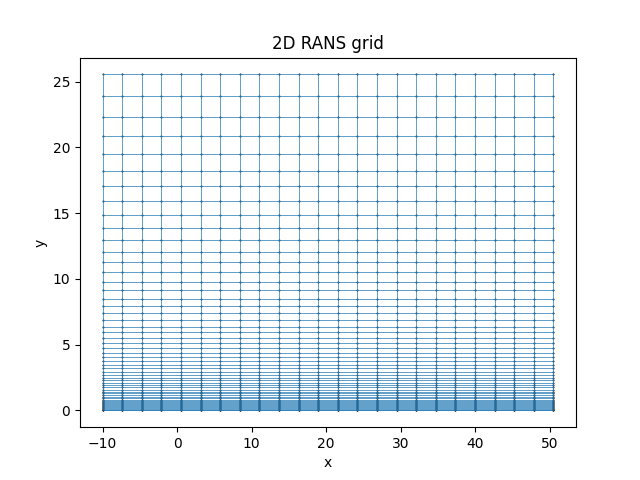
The x-y-slice of the created 3D LES grid should look like this:
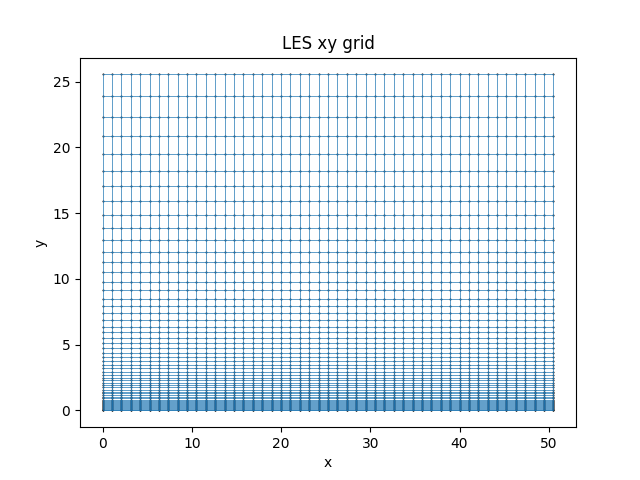
As can be seen in the plots above, the grid (mesh) becomes finer near the wall ( \( y = 0 \)) than distant from the wall ( \( y > 0 \)).
Moreover, some important information and properties are also printed to the console:
RANS grid size:x: 24y: 55RANS domain size:lx = 60.524815518916114ly = 25.554995681912455RANS grid distances:dx = 2.6315137182137436dy_wall = 0.05263027436427487dy_edge = 1.6605366020348526LES grid size:x: 49y: 55z: 51LES domain size:lx = 50.52506338970387ly = 25.554995681912455lz = 13.157568591068717LES grid distances:dx = 1.0526054872854975dy_wall = 0.05263027436427487dy_edge = 1.6605366020348526dz = 0.2631513718213743Alternatively you can open the hdf5 grid files with HDFView and have a closer look at the data structure used in the hdf5-files.
hdfview grid_rans.hdf5hdfview grid_les.hdf5When opened with HDFView, the created 2D RANS grid should look like this:

When opened with HDFView, the x-y-slice of the created 3D LES grid should look like this:
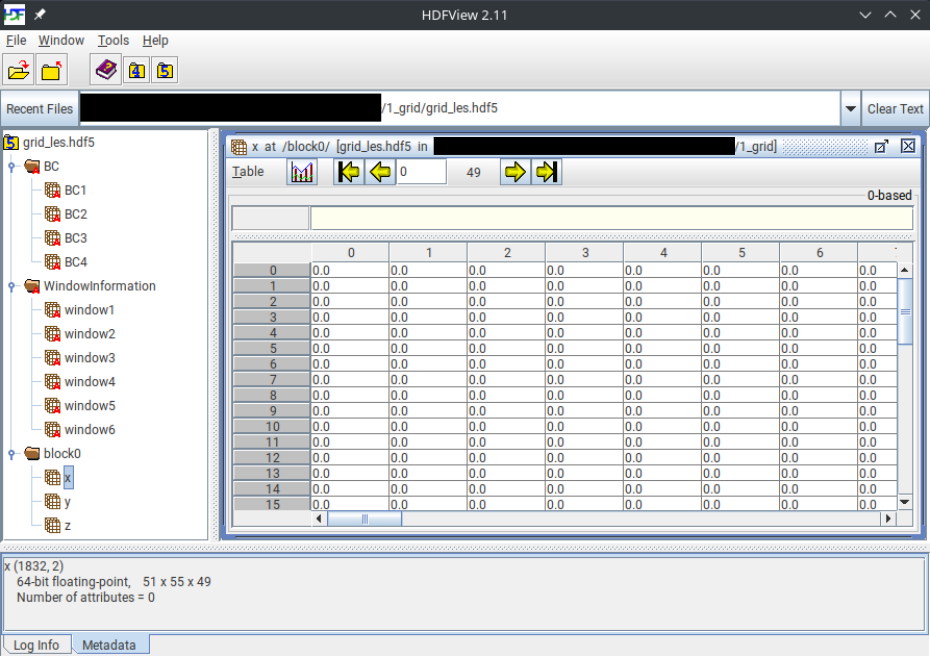
Change some properties in the
properties_grid.tomlfile, such as modifying the domain size usinglx, lyor coarsening the grid resolution usingdx_plus, dy_plus_wall, dy_plus_edgeor usinglx_fringe_growth = 1.05, and rerun steps 3 to 5 and have a look how the changed settings affect the created grids. Tip: Clear the previously created grids by runningclear_grid.pyand deleting them manually.
References
- Albers, M., Meysonnat, P. S., Fernex, D., Semaan, R., Noack, B. R., & Schröder, W. (2020). Drag reduction and energy saving by spanwise traveling transversal surface waves for flat plate flow. Flow, Turbulence and Combustion, 105(1), 125-157. https://link.springer.com/article/10.1007/s10494-020-00110-8.
TODOs
- Todo:
- Revise the make_grid.py file and add more comments and explanations. Remove ZFS namings and unnecessary uncommented code.
- Todo:
- Add information about the dimensions/units: Inner vs. out units. Or at least link to the section, where the units are explained.
- Formula of how the wave propagates. Maybe just add this to the actuated LES tutorial.